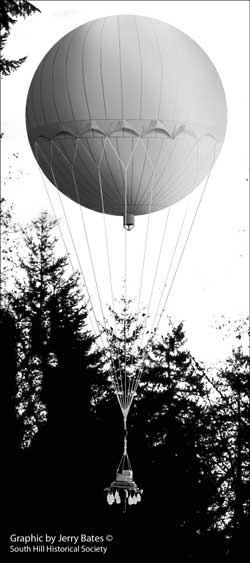The Bombing of South Hill
by Carl Vest

Each March the members of the South Hill Historical Society ask the residents of the area to pause and help commemorate an event that dates from World War II. It was in March 1945 that the war’s violence was experienced locally when the Japanese bombed South Hill. There were two bombing sites, one near present-day Rogers High School and a second near today’s Pope Elementary School.
The Japanese program for this bombing campaign was named Project Fu-Go. It was an unmanned balloon borne weapon system. Bombs were launched after being tied to 30-foot diameter paper balloons. On some missions the system carried incendiary weapons while others had antipersonnel explosives. It took about three days for the assembly to ride the winter jet stream over Japan to the North American coast. A timer released the weapons at a predetermined interval. The system could be considered an early version of the Intercontinental Missile developed after WWII. The Japanese name for the system comes from the first two letters of the Japanese name for balloons “Fu,” and “Go” a numerical classification. In some American archives it’s called Project Paper.
Project Fu-Go was initiated as a result of the historic Doolittle Raid of April 18, 1942. The Japanese Government wanted a way to drop ordnance on American cities as the Doolittle Raiders had done in their country. A research and development project was started by the Army’s Science Research Institute in the summer of 1942. A number of approaches were explored and the balloon bomb approach was finally selected as being the most feasible.
The first bomb was launched on November 3, 1944. It landed in Thermopolis, Wyoming. Kalispell, Montana was hit on December 11, 1944. Just how many bombs were eventually launched is really unknown as most records were destroyed at the end of the war. An estimate of about 350, however, is considered reasonable based on recorded crash points. Impacts were logged as far east as Iowa and in the Canadian Provinces as far north as Hudson Bay. In total some 16 western states were known targets. It’s believed that about 21 projectiles hit objectives within the State of Washington or about six percent of the total.
The first bomb struck South Hill on March 1, 1945. It did not explode. It landed on the Massey farm just off present-day 152nd Street — which is near Pope Elementary School. Mr. Massey discovered the balloon in a tree and pulled it down. He cut the balloon into strips and gave them to his children for keepsakes. His late son, Arthur Massey brought his segment to several meetings of the South Hill Historical Society for display.
The second bomb landed on March 5, 1945. This one exploded. It hit just south of the present-day intersection of 94th Avenue and 128th Street, near the current location of the Mormon Church and Rogers High School. Only fragments survived and they were quickly removed by Army personnel from Fort Lewis who came to secure the area.
Carl Vest, PhD, is a founding member and Research Director for the South Hill Historical Society.